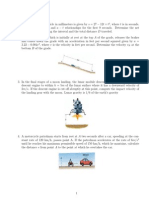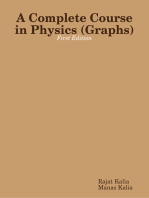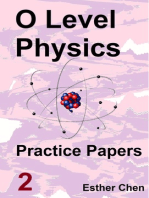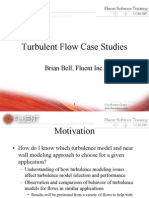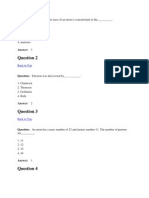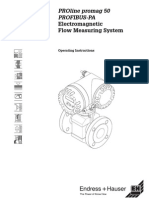0 ratings0% found this document useful (0 votes)
2K viewsExamples 4
This document contains descriptions of 16 physics problems involving motion with varying linear and angular velocities, accelerations, and relative motion. The problems involve objects moving in circular, spiral, and straight paths as well as fluid dynamics scenarios. Kinematic quantities like velocity and acceleration are to be determined for the objects at specific points in time based on the given information about their motions.
Uploaded by
Krisha Ann M. MendozaCopyright
© © All Rights Reserved
Available Formats
Download as PDF, TXT or read online on Scribd
0 ratings0% found this document useful (0 votes)
2K viewsExamples 4
This document contains descriptions of 16 physics problems involving motion with varying linear and angular velocities, accelerations, and relative motion. The problems involve objects moving in circular, spiral, and straight paths as well as fluid dynamics scenarios. Kinematic quantities like velocity and acceleration are to be determined for the objects at specific points in time based on the given information about their motions.
Uploaded by
Krisha Ann M. MendozaCopyright
© © All Rights Reserved
Available Formats
Download as PDF, TXT or read online on Scribd
You are on page 1/ 18
Class Examples
Mapundi Kondwani Banda
MKBanda@sun.ac.za
Applied Mathematics Division - Mathematical Sciences
Stellenbosch University
August 20, 2013
Chapter 12:
Problem 12.164
A radar gun at O rotates with the angular velocity
of
= 0.1 rad/s and angular acceleration of
= 0.025 rad/s
2
, at the instant = 45
, as it
follows the motion of the car traveling along the
circular road having a radius of r = 200 m.
Determine the magnitudes of velocity and
acceleration of the car at this instant.
Problem 12.166
If a particles position is described by the polar
coordinates r = (2 sin 2) m and = (4t) rad,
where t is in seconds, determine the radial and
transverse components of its velocity and
acceleration when t = 1 s.
Problem 12.168
The peg moves in the curved slot dened by the
lemniscate, and through the slot in the arm. At
= 30
, the angular velocity is
= 2 rad/s, and the
angular acceleration is
= 1.5 rad/s
2
. Determine
the magnitudes of the velocity and acceleration of
peg P at this instant.
Problem 12.190
The box slides down the helical ramp such that
r = 0.5m, = (0.5t
3
) rad, and z = (2 0.2t
2
m,
where t is in seconds. Determine the magnitudes of
the velocity and acceleration of the box at the
instant = 2 rad.
Problem 12.184
The slotted arm AB drives pin C through the spiral
groove described by the equation r = (1.5) m,
where is in radians. If the arm starts from rest
when = 60
and is driven at an angular velocity of
(4t) rad/s where t is in seconds, determine the
radial and transverse components of velocity and
acceleration of the pin C when t = 1 s.
Problem 12.160
A particle travels around a limaon, dened by the
equation r = b a cos , where a and b are
constants. Determine the particles radial and
transverse components of velocity and acceleration
as a function of and its time derivatives.
Problem 12.202
Determine the time needed for the load at B to
attain a speed of 8 m/s starting from rest, if the
cable is drawn into the motor with an acceleration
of 0.2 m/s
2
.
Problem 12.200
The motor at C pulls in the cable with an
acceleration a
C
= (3t
2
) m/s
2
, where t is in
seconds.The motor at D draws in its cable at
a
D
= 5 m/s
2
. If both motors start at the same
instant from rest when d = 3 m, determine (a) the
time needed for d = 0, and (b) the relative velocity
of block A with respect to block B when this occurs.
Problem 12.205
If the rope is drawn toward the motor M at a speed
of v
M
= (5t
3/2
) m/s, where t is in seconds,
determine the speed of cylinder A when t = 1 s.
Problem 12.214
The man pulls the boy up to the tree limb C by
walking backward. If he starts from rest when
x
A
= 0 and moves backward with a constant
acceleration a
A
= 0.2 m/s
2
, determine the speed of
the boy at the instant y
B
= 4 m. Neglect the size of
the limb.When x
A
= 0, y
B
= 8 m, so that A and B
are coincident, i.e., the rope is 16 m long.
Problem 12.218
The man can row the boat in still water with a
speed of 5m/s. If the river is owing at 2 m/s,
determine the speed of the boat and the angle he
must direct the boat so that it travels from A to B.
Problem 12.226
A car is traveling north along a straight road at 50
km/h. An instrument in the car indicates that the
wind is coming from the east. If the cars speed is
80 km/h, the instrument indicates that the wind is
coming from the north-east. Determine the speed
and direction of the wind.
Problem 12.228
At the instant shown, the bicyclist at A is traveling
at 7 m/s around the curve on the race track while
increasing his speed at 0.5 m/s
2
. The bicyclist at B
is traveling at 8.5 m/s along the straight-a-way and
increasing his speed at 0.7 m/s
2
. Determine the
relative velocity and relative acceleration of A with
respect to B at this instant.
Problem 12.229
At the instant shown car A is traveling with a
velocity of 30 m/s and has an acceleration of 2
m/s
2
along the highway. At the same instant B is
traveling on the trumpet interchange curve with a
speed of 15 m/s, which is decreasing at 0.8 m/s
2
.
Determine the relative velocity and relative
acceleration of B with respect to A at this instant.
Problem 12.235
The ship travels at a constant speed of v
s
= 20 m/s
and the wind is blowing at a speed of v
w
= 10 m/s,
as shown. Determine the magnitude and direction
of the horizontal component of velocity of the
smoke coming from the smoke stack as it appears
to a passenger on the ship.
Problem 12.236
Car A travels along a straight road at a speed of 25
m/s while accelerating at 1.5 m/s
2
. At this same
instant car C is traveling along the straight road
with a speed of 30 m/s while decelerating at 3
m/s
2
. Determine the velocity and acceleration of
car A relative to car C.
You might also like
- Hourglass Workout Program by Luisagiuliet 276% (21)Hourglass Workout Program by Luisagiuliet 251 pages
- The Hold Me Tight Workbook - Dr. Sue Johnson100% (16)The Hold Me Tight Workbook - Dr. Sue Johnson187 pages
- Read People Like A Book by Patrick King-Edited62% (66)Read People Like A Book by Patrick King-Edited12 pages
- Livingood, Blake - Livingood Daily Your 21-Day Guide To Experience Real Health77% (13)Livingood, Blake - Livingood Daily Your 21-Day Guide To Experience Real Health260 pages
- COSMIC CONSCIOUSNESS OF HUMANITY - PROBLEMS OF NEW COSMOGONY (V.P.Kaznacheev,. Л. V. Trofimov.)94% (212)COSMIC CONSCIOUSNESS OF HUMANITY - PROBLEMS OF NEW COSMOGONY (V.P.Kaznacheev,. Л. V. Trofimov.)212 pages
- Donald Trump & Jeffrey Epstein Rape Lawsuit and Affidavits83% (1016)Donald Trump & Jeffrey Epstein Rape Lawsuit and Affidavits13 pages
- The 36 Questions That Lead To Love - The New York Times94% (34)The 36 Questions That Lead To Love - The New York Times3 pages
- The 36 Questions That Lead To Love - The New York Times95% (21)The 36 Questions That Lead To Love - The New York Times3 pages
- Jeffrey Epstein39s Little Black Book Unredacted PDF75% (12)Jeffrey Epstein39s Little Black Book Unredacted PDF95 pages
- Solution Manual For Mechanics of Materials 3rd Edition by Philpot71% (7)Solution Manual For Mechanics of Materials 3rd Edition by Philpot53 pages
- The 4 Hour Workweek, Expanded and Updated by Timothy Ferriss - Excerpt23% (954)The 4 Hour Workweek, Expanded and Updated by Timothy Ferriss - Excerpt38 pages
- Engineering Mechanics Assignment No.1: KINEMATICS OF PARTICLE: Motion Related To Cartesian Coordinates, RectilinearNo ratings yetEngineering Mechanics Assignment No.1: KINEMATICS OF PARTICLE: Motion Related To Cartesian Coordinates, Rectilinear3 pages
- Rectilinear Motion: Variable AccelerationNo ratings yetRectilinear Motion: Variable Acceleration11 pages
- Documents - Tips - Practical Class 2 Solutions PDFNo ratings yetDocuments - Tips - Practical Class 2 Solutions PDF16 pages
- Wrong Answer: (-1 Point) Blank: (0 Point) - Maximum Mark Is 25 Point and Minimum Mark Is ZeroNo ratings yetWrong Answer: (-1 Point) Blank: (0 Point) - Maximum Mark Is 25 Point and Minimum Mark Is Zero4 pages
- Math142 - Tutorial 3 Additional Problems 11-15 August 2014No ratings yetMath142 - Tutorial 3 Additional Problems 11-15 August 20142 pages
- Problem Set 1 - Rectilinear w Variable AccelerationNo ratings yetProblem Set 1 - Rectilinear w Variable Acceleration2 pages
- Dinamik & Mechanism BMCG1253 Kinematic of Particles: Rectangular Components of Curvilinear MotionNo ratings yetDinamik & Mechanism BMCG1253 Kinematic of Particles: Rectangular Components of Curvilinear Motion3 pages
- Problem Set 2 Dynamics Acceleration Velocity PDFNo ratings yetProblem Set 2 Dynamics Acceleration Velocity PDF2 pages
- Dynamics Tutorial Sheet 2 - Particle Kinematics - Curvilinear Motion and Relative MotionNo ratings yetDynamics Tutorial Sheet 2 - Particle Kinematics - Curvilinear Motion and Relative Motion6 pages
- Assignment One (Individual) : WorksheetNo ratings yetAssignment One (Individual) : Worksheet11 pages
- Chapter 2: Motion Along A Straight LineNo ratings yetChapter 2: Motion Along A Straight Line20 pages
- Applications of Derivatives Rate of Change (Calculus) Mathematics Question BankFrom EverandApplications of Derivatives Rate of Change (Calculus) Mathematics Question BankNo ratings yet
- Turbulent Flow Case Studies: Brian Bell, Fluent IncNo ratings yetTurbulent Flow Case Studies: Brian Bell, Fluent Inc142 pages
- Ease 4 Physics Pointer Analyses and Practice QuestionsNo ratings yetEase 4 Physics Pointer Analyses and Practice Questions11 pages
- Overview of Zirconia Application As Denture Base Material Substituting For MetalNo ratings yetOverview of Zirconia Application As Denture Base Material Substituting For Metal4 pages
- Failure Investigation of Fuel Tubes of A Jet Engine Augmenter AssemblyNo ratings yetFailure Investigation of Fuel Tubes of A Jet Engine Augmenter Assembly3 pages
- A New Approach Towards The Synthesis of Six-Bar Double Dwell MechanismsNo ratings yetA New Approach Towards The Synthesis of Six-Bar Double Dwell Mechanisms9 pages
- Fluent-Fsi 14.0 ws3 Hyperelastic Flap Part1100% (1)Fluent-Fsi 14.0 ws3 Hyperelastic Flap Part122 pages
- New Methods For Teaching Introductory Physics To Non-MajorsNo ratings yetNew Methods For Teaching Introductory Physics To Non-Majors11 pages
- Livingood, Blake - Livingood Daily Your 21-Day Guide To Experience Real HealthLivingood, Blake - Livingood Daily Your 21-Day Guide To Experience Real Health
- COSMIC CONSCIOUSNESS OF HUMANITY - PROBLEMS OF NEW COSMOGONY (V.P.Kaznacheev,. Л. V. Trofimov.)COSMIC CONSCIOUSNESS OF HUMANITY - PROBLEMS OF NEW COSMOGONY (V.P.Kaznacheev,. Л. V. Trofimov.)
- Donald Trump & Jeffrey Epstein Rape Lawsuit and AffidavitsDonald Trump & Jeffrey Epstein Rape Lawsuit and Affidavits
- The 36 Questions That Lead To Love - The New York TimesThe 36 Questions That Lead To Love - The New York Times
- The 36 Questions That Lead To Love - The New York TimesThe 36 Questions That Lead To Love - The New York Times
- Jeffrey Epstein39s Little Black Book Unredacted PDFJeffrey Epstein39s Little Black Book Unredacted PDF
- Solution Manual For Mechanics of Materials 3rd Edition by PhilpotSolution Manual For Mechanics of Materials 3rd Edition by Philpot
- The 4 Hour Workweek, Expanded and Updated by Timothy Ferriss - ExcerptThe 4 Hour Workweek, Expanded and Updated by Timothy Ferriss - Excerpt
- Engineering Mechanics Assignment No.1: KINEMATICS OF PARTICLE: Motion Related To Cartesian Coordinates, RectilinearEngineering Mechanics Assignment No.1: KINEMATICS OF PARTICLE: Motion Related To Cartesian Coordinates, Rectilinear
- Documents - Tips - Practical Class 2 Solutions PDFDocuments - Tips - Practical Class 2 Solutions PDF
- Wrong Answer: (-1 Point) Blank: (0 Point) - Maximum Mark Is 25 Point and Minimum Mark Is ZeroWrong Answer: (-1 Point) Blank: (0 Point) - Maximum Mark Is 25 Point and Minimum Mark Is Zero
- Math142 - Tutorial 3 Additional Problems 11-15 August 2014Math142 - Tutorial 3 Additional Problems 11-15 August 2014
- Problem Set 1 - Rectilinear w Variable AccelerationProblem Set 1 - Rectilinear w Variable Acceleration
- Dinamik & Mechanism BMCG1253 Kinematic of Particles: Rectangular Components of Curvilinear MotionDinamik & Mechanism BMCG1253 Kinematic of Particles: Rectangular Components of Curvilinear Motion
- Dynamics Tutorial Sheet 2 - Particle Kinematics - Curvilinear Motion and Relative MotionDynamics Tutorial Sheet 2 - Particle Kinematics - Curvilinear Motion and Relative Motion
- A Complete Course in Physics (Graphs) - First EditionFrom EverandA Complete Course in Physics (Graphs) - First Edition
- O level Physics Questions And Answer Practice Papers 2From EverandO level Physics Questions And Answer Practice Papers 2
- Applications of Derivatives Rate of Change (Calculus) Mathematics Question BankFrom EverandApplications of Derivatives Rate of Change (Calculus) Mathematics Question Bank
- Turbulent Flow Case Studies: Brian Bell, Fluent IncTurbulent Flow Case Studies: Brian Bell, Fluent Inc
- Ease 4 Physics Pointer Analyses and Practice QuestionsEase 4 Physics Pointer Analyses and Practice Questions
- Overview of Zirconia Application As Denture Base Material Substituting For MetalOverview of Zirconia Application As Denture Base Material Substituting For Metal
- Failure Investigation of Fuel Tubes of A Jet Engine Augmenter AssemblyFailure Investigation of Fuel Tubes of A Jet Engine Augmenter Assembly
- A New Approach Towards The Synthesis of Six-Bar Double Dwell MechanismsA New Approach Towards The Synthesis of Six-Bar Double Dwell Mechanisms
- New Methods For Teaching Introductory Physics To Non-MajorsNew Methods For Teaching Introductory Physics To Non-Majors










































